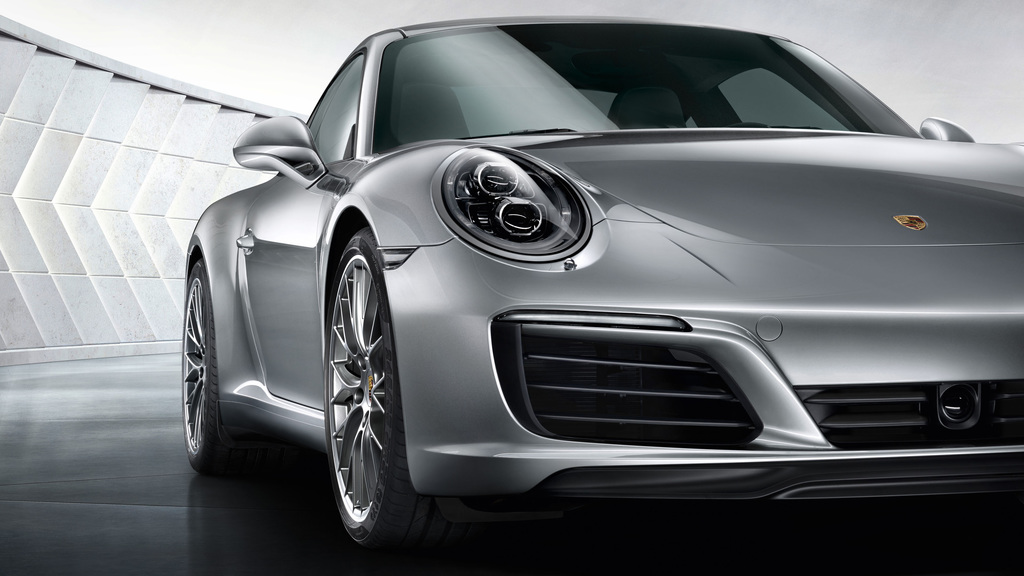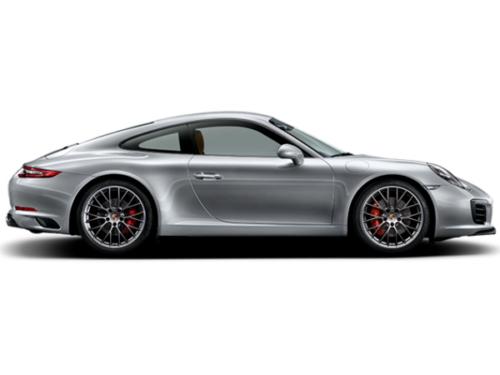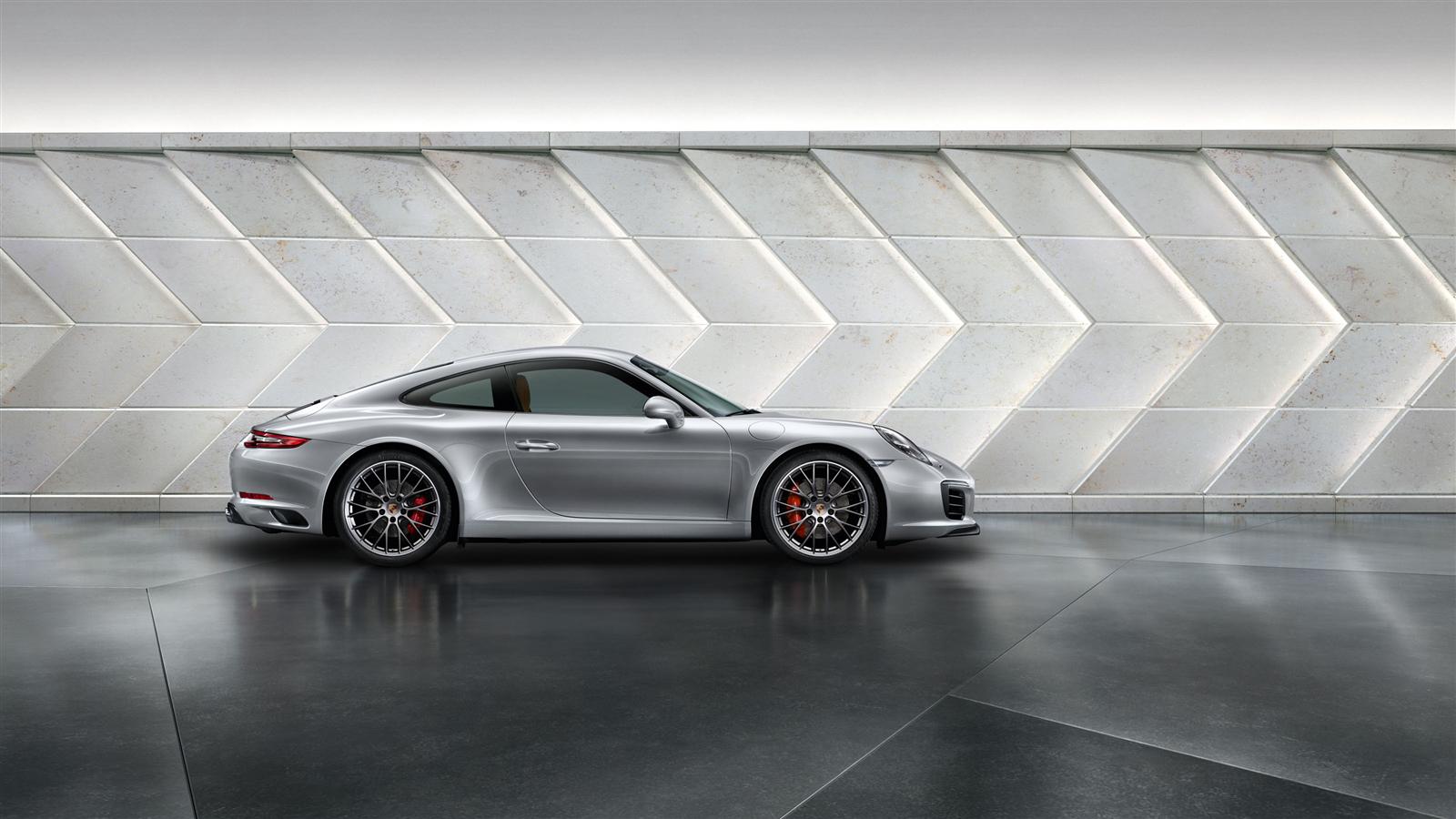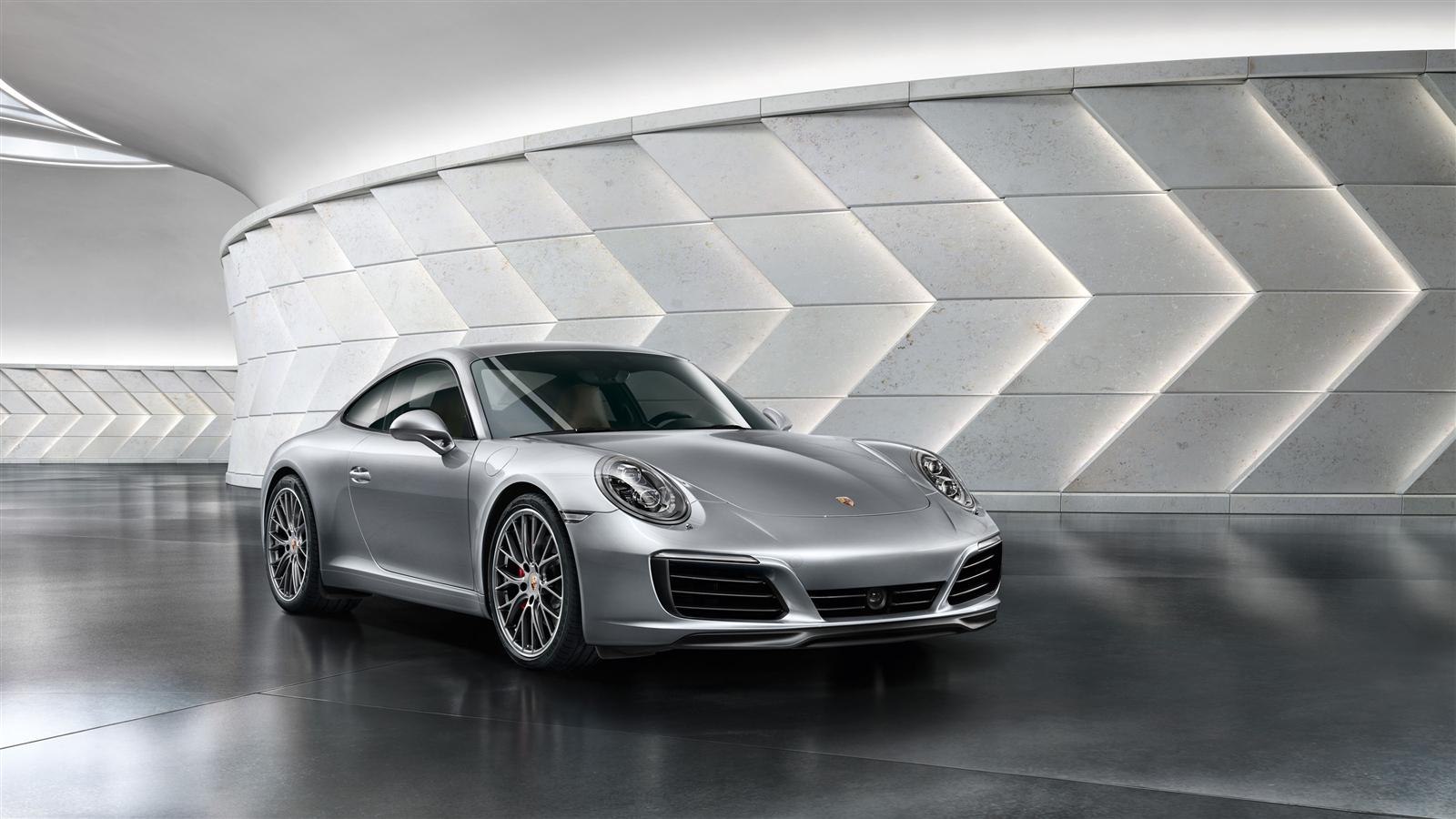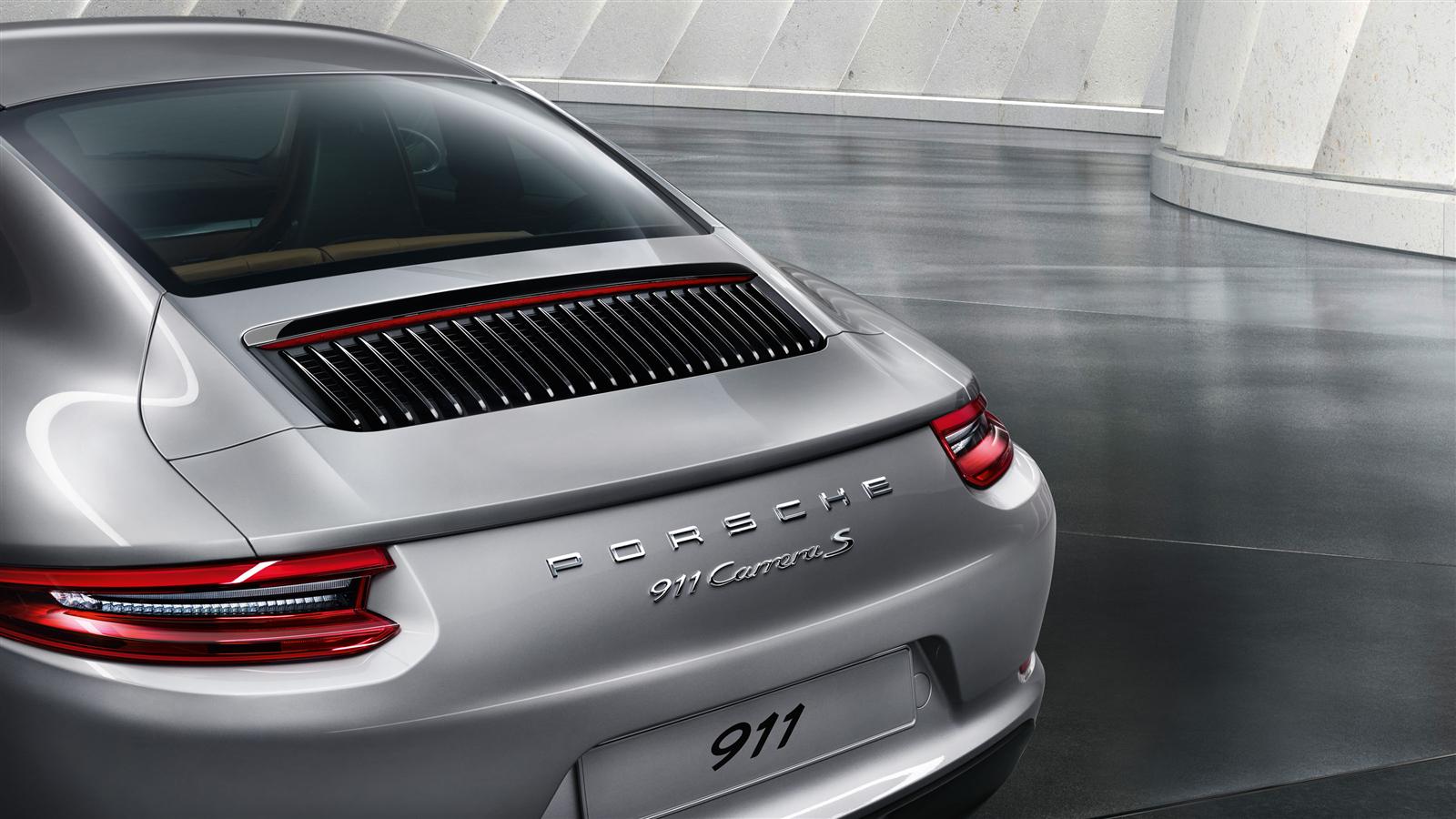(2016 – 2019) Porsche 911 Carrera S (991.2) – Ultimate Guide
The 991.2 generation 911 Carrera S replaces the 991.1 Carrera S. The mid-cycle refreshes are normally simple affairs at Porsche, but not this time around. Gone is the 3.8-litre naturally aspirated engine in favor of a more emission-friendly 3.0-litre twin-turbo flat six, all in the name of improved performance and better fuel efficiency. On the face of it, more power and torque with lower fuel usage is always a good thing, but as Porsche fans we want to make sure that doesn’t come at the cost of engagement and enjoyment.
The completely new engine generation gets two turbos and the familiar flat six layout. Power is now 414 bhp @ 6500 rpm and torque is 368 ft lbs @ 1700 rpm. Power is basically up 20 hp versus the prior generation Carrera S and a whopping 43 ft lbs of torque. Note that both the the base Carrera and Carrera S have the same 3.0 liter displacement, but the Carrera S gets more horsepower and torque thanks for different turbochargers with modified compressors, a specific exhaust system and tuned engine management.
The new Carrera S engine is characterized by significantly increased torque and by delivering that max torque at a low 1,700 rpm up to 5,000 rpm, ensuring excellent pulling power throughout the entire rev range. There’s not much let up in the torque delivery either, with the two small Borg Warner turbochargers having to deal with just 1.5 litres of capacity each, allowing for quick spooling and pressure build up. The biggest difference from the old car is that you don’t really need to rev it all the way to redline to get the most out of it. You’d be faster shifting up earlier to get the benefit of the turbochargers in the optimum rev range. That instinctively changes the character of the Carrera S. Gone is that raw growl, the one that screamed at 7500rpm with the most delightful note out of a six-cylinder in existence. In its place is a far more subdued note, one that sounds more technical, mixed in with the whistle of two turbochargers. It still screams – but not in the same tone – and if you option the sports exhaust package (which takes away the quad-pipes for two larger centre-mounted exhausts), it gets a little more edgy.
Autoexpress: It feels ferocious off the line and the mid-range shove from those two turbos force-feeding the engine with air is eye-widening….the boost builds quickly and the engine still revs with linearity all the way to the 7,500rpm limiter.
The new Carrera S sits 10mm lower than before and the Porsche Adaptive Suspension Management (PASM) is now standard across the range. Porsche has modified the dampers and springs with better rebound across more surfaces. For the first time on a Carrera S you can now option rear-axle steering (previously only on GT3 and 911 Turbo), which allows the rear wheels to further aid in getting you the right angle in hairpins (or tight car parks). Our test cars all had the system, and it was useful, but it’s not a necessity and it’s only available when packaged with Porsche Dynamic Chassis Control (PDCC). Porsche has added a Sport Response button, too, that primes the engine for maximum power and changes down to the perfect gear, delivering a 20-second burst of performance for when you’re overtaking on road or track.
In conjunction with the optional Sport Chrono Package the 911 Carrera now has a mode switch on the steering wheel for the first time, derived from the hybrid mode switch of the 918 Spyder. The mode switch consists of a rotary ring with four positions for the driving modes “Normal”, “Sport”, “Sport Plus” and “Individual”. Depending on the equipment, the latter setting enables drivers to configure their own individual vehicle set-up, for example the PASM, active engine mounts, PDK shifting strategy and sports exhaust system. In combination with PDK transmission the mode switch has an additional button, the “Sport Response Button”. When this button is pressed the drivetrain is pre-conditioned for maximum acceleration for 20 seconds, for example before overtaking manoeuvres. For this, the optimum gear is engaged and the engine management adjusted to an even more spontaneous response for a short time.
Autocar: With the torque arriving so much earlier, there’s no pressing need to keep the engine stoked with frequent visits to lower ratios to ensure solid levels of in-gear acceleration. An earnest nudge of the throttle in all but the highest ratios is now sufficient to unlock the haughty performance potential.
With the Sport Chrono package optioned, the 991.2 Carrera S can go from 0-60 mph in just 3.7 seconds (PDK). That is mighty quick. For reference, that’s quicker than a 997 Porsche 911 Turbo and 0.2 seconds quicker than the car it replaces. Without Sport Chrono, it still does it in a very fast 3.9 seconds with the PDK option. Top speed is now 191 mph and the quarter mile is demolished in just 11.8 seconds.
From the outside, the updated 911 Carrera S isn’t all that distinguishable to the average punter from the car it replaces, though the front and rear bumpers are entirely new, as are the door handles and the air intakes and outlets for the turbochargers at the back. There are subtle changes to the headlights (four LED daytime running lights) as well the tail-lights, but ultimately the easiest way to tell the new car apart is the exhaust vents of the intercoolers sitting low and far to the sides of the rear bumper and the rear lights with their 3D effect. It’s similar, but different enough.
Inside, Porsche has added a new seven-inch touchscreen sat-nav system that incorporates online navigation and clever gesture control. Spec the Apple CarPlay feature and you’ll be able to slickly connect your iPhone to the 911 for real-time traffic info and other connected services.
New smartphone apps help here too, and a quick play with the system showed an improvement over the regular touchscreen in the old 911, so it’s another feature that highlights just how usable this Carrera S will be. Two small rear seats and a 145-litre boot in the nose is the icing on the cake.
The Reviews
Pictures
Press Release
The Porsche 911 has been the world’s best-selling sports car for decades. Now the new generation has arrived to further extend this lead. With innovative turbo flat engines, an advanced chassis with an even greater spread between performance and comfort and a new infotainment system it is exceedingly well-equipped for this. Thanks to more than four decades of experience with turbo engines – in both motor racing and production sports cars – the new engines in the new 911 Carrera set benchmarks in terms of performance, driving pleasure and efficiency. The rear-axle steering available as an option for the Carrera models for the first time further greatly extends the range of driving dynamics.
Many exterior features of the 911 Carrera have been visually refined: these range from new headlights with four-point daytime running lights to door handles without recess covers, a redesigned rear lid with vertical louvres and new rear lights – including the characteristic four-point brake lights. In the interior the new standard Porsche Communication Management with a multi-touch display offers a considerably expanded range of functions and greatly simplified operation.
New turbocharged engines: 20 hp power increase coupled with lower fuel consumption
The completely new engine generation with bi-turbo charging raises the emotional driving pleasure in the 911 Carrera to an even more intensive experience: 370 hp (272 kW) of power at the rear of the 911 Carrera is waiting to be unleashed and converted into sporty propulsion. The engine in the 911 Carrera S now delivers 420 hp (309 kW). In both cases this represents a power increase of 20 hp (15 kW). Both engines have a displacement of three litres. The greater power of the 911 Carrera S results from turbochargers with modified compressors, a specific exhaust system and tuned engine management.
The new Porsche engines are characterised by significantly increased torque (60 Nm in each case) with maximum torque of 450 Nm and 500 Nm respectively delivered constantly from a low 1,700 rpm up to 5,000 rpm in both cases, thus ensuring excellent driving performance. At the same time with a maximum speed of 7,500 rpm the new engine generation clearly exceeds the top speeds of conventional turbo engines – underscored by the typical sonorous Porsche engine sound.
Every new 911 generation boasts enhanced performance and efficiency compared with the predecessor. For example, depending on the model variant, the new engine generation is almost twelve percent more efficient: fuel consumption is reduced by up to a litre per 100 kilometres. The 911 Carrera with PDK transmission now consumes just 7.4 litres of fuel per 100 kilometres (a reduction of 0.8 l per 100 km), while the 911 Carrera S with PDK consumes 7.7 l/100 km (1.0 l less per 100 km).
The new 911 also boasts impressive performance: the 911 Carrera Coupé with Porsche-Doppelkupplung (PDK) and Sport Chrono Package sprints from zero to 100 km/h in 4.2 seconds – making it two tenths of a second faster than its predecessor. The 911 Carrera S with PDK and Sport Chrono Package performs its showcase discipline in just 3.9 seconds (also 0.2 s faster). This means that it is the first 911 in the Carrera family to undercut the magic four second mark. And the top speeds of both models have also increased further: the 911 Carrera now has a top speed of 295 km/h (an increase of six km/h), while the 911 Carrera S now even reaches 308 km/h (an increase of four km/h).
In conjunction with the optional Sport Chrono Package the 911 Carrera now has a mode switch on the steering wheel for the first time, derived from the hybrid mode switch of the 918 Spyder. The mode switch consists of a rotary ring with four positions for the driving modes “Normal”, “Sport”, “Sport Plus” and “Individual”. Depending on the equipment, the latter setting enables drivers to configure their own individual vehicle set-up, for example the PASM, active engine mounts, PDK shifting strategy and sports exhaust system. In combination with PDK transmission the mode switch has an additional button, the “Sport Response Button”. When this button is pressed the drivetrain is pre-conditioned for maximum acceleration for 20 seconds, for example before overtaking manoeuvres. For this, the optimum gear is engaged and the engine management adjusted to an even more spontaneous response for a short time.
A standard feature: reengineered PASM chassis lowers the ride height by ten millimetres
The 911 Carrera is the benchmark for driving dynamics of all-round sports cars. With every new generation Porsche further increases the spread between everyday comfort and circuit performance. For the first time, the new PASM chassis (Porsche Active Suspension Management), which lowers the ride height by ten millimetres, is a standard feature on board all Carrera models. It further improves stability during fast cornering. At the same time the new shock absorber generation with its wider spread characteristics enhance comfort thanks to an even more precise response characteristic and also improve the body connection during dynamic driving. New standard wheels with five slim twin spokes carry tyres with reduced rolling resistance and enhanced performance. Furthermore, on all variants the width of the rear rims has increased by 0.5 to 11.5 inches and the rear tyres of the 911 Carrera S now measure 305 instead of 295 millimetres.
The active rear-axle steering that is available as an option for the 911 Carrera S is chassis technology adopted from the 911 Turbo and 911 GT3. It further enhances the turn-in behaviour of the 911. In addition, it makes for high driving stability when changing lanes at high speeds. At the same time it ensures greater manoeuvrability in city traffic thanks to the turning circle reduced by 0.5 metres. The improved handling is transmitted to the driver via the new steering wheel generation with a design based on the steering wheel of the 918 Spyder. The basic steering wheel has a diameter of 375 millimetres; the optional GT sports steering wheel measures 360 millimetres. For unlimited everyday practicality Porsche offers a hydraulic lift system with integrated lifting cylinders in the struts of the front axle. Pressing a button increases the ground clearance at the front by 40 millimetres within 5 seconds and thus prevents the vehicle underbody from hitting the ground, for example on steep garage exits.
New Porsche Communication Management including online navigation
A standard feature of the new 911 Carrera models is the newly developed Porsche Communication Management System (PCM) including online navigation module and voice control. The PCM can be operated by performing multi-touch gestures on the seven-inch display, similar to operating a smartphone. User inputs by handwriting are possible, for instance. Mobile phones and smartphones can now also be connected via Wi-Fi. The smartphone tray being integrated for the first time in the centre armrest also offers battery-saving charging and optimised mobile phone reception. Also new is the option of connecting an iPhone to the PCM to use Apple CarPlay.
Real-time traffic information is available for significantly improved navigation. It gives the driver a quick overview of the traffic situation and guarantees dynamic adaptation of the route to this information. Google Earth and Google Streetview are also being integrated for the first time to offer better orientation. Other components of the PCM are Porsche Car Connect and the Porsche Connect app, which can be used for such functions as remote control of vehicle functions, transfer of destinations to the PCM for navigation and use of music streaming services by third-party providers via the PCM.
New and extended optional assistance systems
The 911 Carrera can now be customised even more precisely according to personal preferences with further new and improved assistance systems: the optional automatic speed control can now also brake moderately when the pre-set speed is exceeded, for example when driving downhill. The Adaptive Cruise Control ACC (option) now has a coasting function in conjunction with a PDK transmission. When driving in a queue the clutches are disengaged, thus saving fuel with unpowered coasting. The optional lane change assistant monitors traffic behind with radar and uses LED lamps in the left and right of the mirror triangle to warn the driver about approaching vehicles in the blind spot. In addition, Porsche increases the active safety of the sports car with the post-collision braking system as a standard feature.
Market launch in December 2015
The new Porsche 911 Carrera models will be launched in Germany on December 12, 2015 at the following prices including VAT and country-specific equipment:
911 Carrera – 96,605 euros
911 Carrera S – 110,766 euros
911 Carrera Cabriolet – 109,695 euros
911 Carrera S Cabriolet – 123,856 euros
40 years’ turbo experience in motorsport and series production
At Porsche, innovations and developments that have proved themselves under extreme racing conditions always benefit production models, too. Testing in motorsport in particular ensures the performance and resilience of new engines for production sports cars. In the development of charged six-cylinder flat engines Porsche can therefore look back on more than 40 years’ experience. For example, turbocharging with a bypass valve was first used in 1972 in the 917/10 racing car before entering series production two years later in 1974 in the first 911 Turbo. In 1974 charge air cooling was also first introduced in the 917/10. In 1977 this technology then celebrated its premiere in the 911 Turbo 3.3. Further milestones in the development of turbo engines include sequential turbocharging with two consecutive chargers (for the first time in the super car 959), bi-turbo charging with two parallel chargers (for the first time in the 911 Turbo, type 993) and adjustable intake valves (for the first time in the 911 Turbo, type 996).


